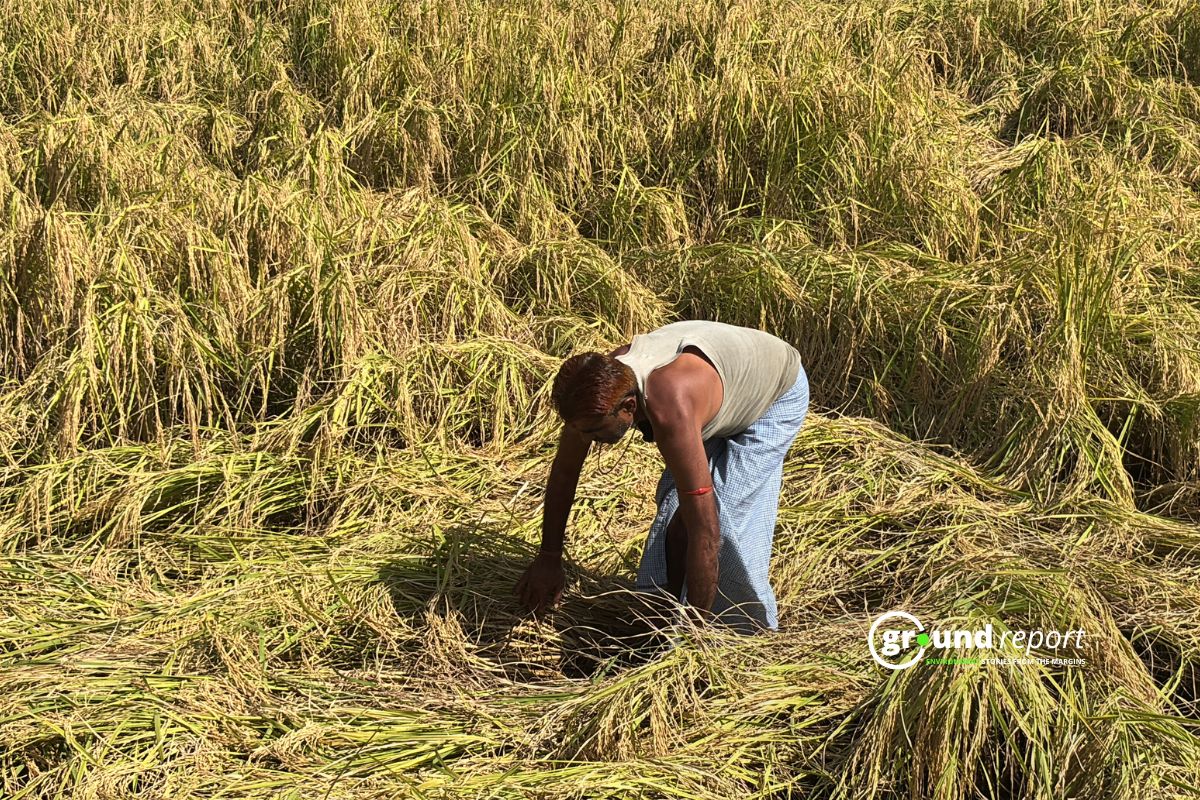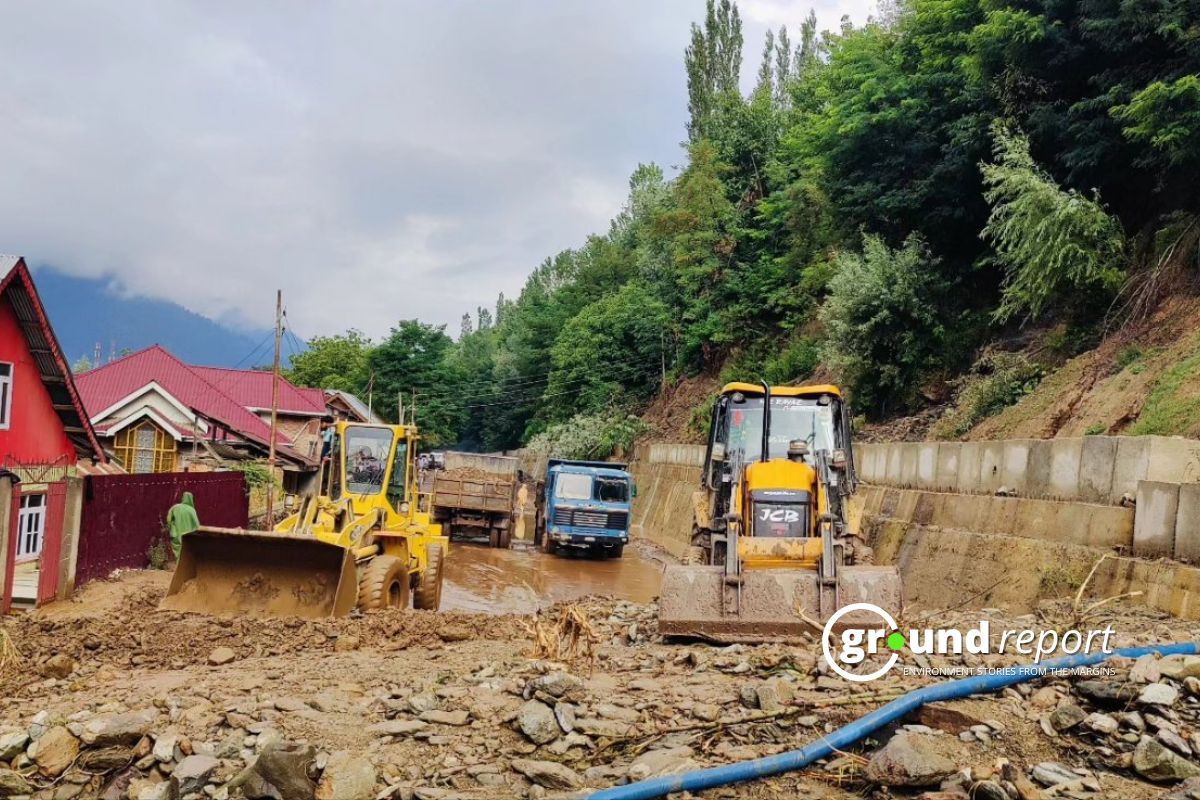In the remote village of Noorganj in Madhya Pradesh’s Raisen district, Ranjit Singh Nagar recalls his introduction to solar-powered irrigation seven years ago. It was the month of Baishakh in 2018 when he first learned about solar pumps. He was sitting at a friend’s house in Dahod village, approximately 5.5 kilometers away.
His friend told Ranjit Singh Nagar about the government assistance available on solar pumps. Seeing his problem being solved cheaply, he immediately applied for the government scheme.
“It was like a village fair,” Nagar remembers of the morning when over 50 curious locals gathered to witness the installation of gleaming blue solar panels. “People watched with astonishment, as if a Bollywood film scene was unfolding before their eyes.”
The spectacle drew farmers from throughout the area, each arriving with their theories about the unfamiliar technology that would soon transform agricultural practices across the region.
The 74-year-old farmer’s eyes brighten at the memory. “It seemed like pure magic to see water flowing from the ground without electricity,” he recalls.
The technology that once astonished villagers is now set to transform rural Madhya Pradesh. In early March this year, Chief Minister Dr. Mohan Yadav announced major agricultural initiatives, including permanent electricity connections for farmers at just Rs 5. The state government also pledged to distribute 30 lakh solar pumps over the next three years.
Ground Report has produced a video investigation on the implementation of this electricity connection scheme. But what about the Chief Minister Solar Pump Scheme, already operating in the state?
To assess its progress, we conducted an in-depth investigation, combining information obtained through Right to Information requests and government documents with extensive on-the-ground reporting.
We sought to determine which farmers are receiving solar pumps, what problems these pumps have solved, and what challenges beneficiaries now face.

Solar pumps in the state
Madhya Pradesh has a long history of schemes related to Solar Pumps.
The alternative irrigation method for farmers was first mentioned in 2017. When the Principal Secretary of the Ministry of New and Renewable Energy had said that the state government would provide about 18,500 solar pumps to the farmers of the state.
Few years later, the PM Kusum Yojana was launched by the central government in 2019. Under this, CM Solar Pump (Kusum B) Phase II connections were given in the state in 2020 and 2021. In August 2022, the central government extended the PM Kusum Yojana till March 2026. The government said that the targets of the scheme have been badly affected due to Covid-19.
Under the third phase of CM Solar Pump (Kusum B), solar pumps started being installed again in 2023. Now after the announcement of the Chief Minister in 2025, this scheme has been extended for the next 3 years.
Sun shines on new possibilities
For Ranjit Nagar, solar irrigation has transformed his agricultural practices since 2018. Across his 20-acre farm, he now cultivates moong (a pulse variety) even during the harsh April heat—something unimaginable seven years ago when he relied on canal irrigation.
“Canal irrigation was exhausting,” Nagar explains. “When water flowed at night, it had to travel three kilometers to reach our fields. The process required four people: one stationed at the canal, another monitoring midway, a third watching the field, while I patrolled with a torch to prevent water theft from breaches along the route.”
He says that even after working so hard, there was not enough water even in his 3 to 4 acres. In such a situation, the 20 acres of land could not be fully utilized. Apart from wheat farming in 4 acres, he was cultivating lentils, chickpeas, and tevda (lathyrus sativus). Until then he did not have a borewell.

Uttam Nagar, another farmer from Prem Talab village, cultivates 17-18 acres of land. In 2017, he invested Rs 74,000 to install a 5 HP (horsepower) solar pump in his field. Before adopting solar technology, Uttam had purchased two diesel generators to compensate for the unreliable electricity supply in the area. However, operating these generators proved extremely costly.
“The generator consumed at least 2 liters of diesel every hour,” Uttam explains.
Similar to Ranjit’s experience, Uttam emphasizes the persistent electricity supply challenges that farmers in the region face, which led him to seek alternative energy solutions.
Power of the pump
But after the introduction of the solar pump, there has been a lot of change. Ranjit has now also dug a borewell. Now that there is adequate water, not only has his production increased, but he is also able to grow moong crops in addition to paddy and wheat. He even says,
“According to us, solar has made a threefold difference. Earlier, we used to grow 70-80 quintals of wheat. Now we grow up to 400 quintals and that is apart from the paddy and moong farming.”
The farmer also says that when there is no electricity in the village, drinking water is also filled from this pump and sent to the village.
For the past 6 years, Ranjit’s 34-year-old son Shivraj Nagar has taken over the farming operations. He explains that frequent power outages remain the village’s most persistent challenge. The aging electrical infrastructure means that when wires break, residents can be left without electricity for up to two days.
However, with their 5 horsepower (HP) solar pump, irrigation continues uninterrupted from 7 am to 5 pm daily. The solar pump has significantly simplified both irrigation and field preparation for wheat cultivation (Palewa). This technological improvement has dramatically increased efficiency—Shivraj can now plow 20 acres in just 7 days.
The advantage of this is that his wheat sowing is done on time, due to which his production per acre (average) has increased. At the beginning of the last Rabi season, the farmers of Raisen itself had complained that due to lack of adequate electricity, many farmers were not able to sow their wheat on time. Ground Report also did a story explaining its effect on wheat production.
In our investigation, we discovered how inadequate electricity supply has forced farmers into both costly and illegal alternatives.
Facing persistent power shortages, many farmers have turned to unauthorized solutions. They get temporary connections to the village’s domestic electricity feeder—which, unlike agricultural lines, offers continuous 24-hour service. While these four-month connections allow for more efficient field preparation, they come with significant drawbacks: each costs approximately ₹43,000, and more importantly, using domestic feeders for agricultural irrigation explicitly violates existing regulations.
The consequences extend beyond legal concerns. The original power limitations delay crucial field preparation, directly threatening wheat production levels. This electricity crisis has created a difficult choice for farmers: risk lower yields or resort to prohibited but more reliable power alternatives.
In this challenging context, solar pumps have emerged as a transformative solution for Ranjit Nagar and numerous farmers facing similar difficulties.
Uttam Singh explains that during winter months, government-supplied electricity is only available during the uncomfortable hours of 10 PM to 2 AM. Previously, farmers had no choice but to endure the bitter cold while standing in their fields during these late-night hours to manage irrigation. The adoption of solar pumps has eliminated this hardship.
With reliable daytime operation, these systems have freed farmers from the physically demanding task of overnight field irrigation, significantly improving both their working conditions and quality of life.
However, one side of this facility is that now crops that require additional water are being produced. For this report, we met 12 farmers. All these farmers were earlier producing limited wheat and pulse crops. But after the facility of solar pumps, all these farmers have started cultivating paddy and moong.

Flaws in our schemes
Madanlal Malviya, a resident of Dahod village in Raisen district, installed a solar pump in 2017. He was confident that this would solve his water and electricity problems. But after 3 years, one of his solar plates got damaged. First, some cracks appeared in one of his plates, and then it stopped working completely. He tried to complain about it on the toll-free number of Shakti Pump. But he did not get any help from their side. Today, even after almost 5 years, his solar plate is lying damaged.
“Due to a damaged plate, the voltage is lower. Earlier, after irrigating 3 acres in 7 days, we used to get drinking water as well, now there is only water for irrigation.”
After-sales service remains a major issue under the scheme. Although the solar pumps installed come with a five-year warranty, during which the installation company is required to provide free repairs in case of any damage, many farmers across the state—including those in Dahod—told us that they received no assistance when they encountered technical problems. Neither did the company offer support, nor did the government department take any action against them.
Delay in installation is another major issue faced by farmers. Rakesh Nagar from Prem Talab village applied for a solar pump back in 2018 and submitted ₹5,000 through a demand draft. However, even after all these years, the pump has not been installed in his field. Another farmer from Hirania village, who is also struggling with water scarcity, is still waiting for his solar pump to be installed.
However, reacting to this, Kamlesh Gehlot, working as an Assistant Engineer in Madhya Pradesh Energy Development Corporation Limited, says that after the current announcement, priority will be given to those farmers who had registered for it earlier in the solar pumps that are to be installed.
Rakesh also told us that he was called to inform that a solar pump will be installed in his field. However, he has no information yet about when this will be installed.
Our investigation revealed that the farmers who took advantage of this scheme in 2018 are very satisfied with it. Most of the people told us that they want to get another solar pump connection after the current announcement. Some of these farmers have even started applying for 10 HP connections.
However, in our investigation, we found that most of the beneficiaries of this scheme are farmers with large land holdings. In different villages of Raisen and Bhopal district, we found only 3 farmers who were farming on 3 acres. These farmers are also farming on a total of 10 or more acres of land along with their brothers.
In Nanakhedi village, solar pumps were installed on the land of only 2 farmers in the first phase. Both these farmers are related to each other, and as told by the villagers, they are farming on about 100 acres of land. The same is the case with Noorganj, where there are 9 connections, out of which 5 farmers live in Bhopal and someone else looks after their farming in Noorganj.
This fact is worth considering because all these farmers are also exploiting the electricity available from the grid. In our investigation, only one farmer was found who is completely dependent on the solar pump. All the other farmers are using it only to extract excess water.

Fewer installations and falling funds
At the beginning of this report, we had asked what is different in the new announcement of the Chief Minister? Answering this question, engineer Gehlot said that earlier the state government used to provide 30% assistance in the scheme, then the central government also used to provide some assistance. Now the state government will provide 60% assistance on its own. It is expected that the rates of solar pumps will decrease due to this and the aim is to make it reach more people.
But as the solar pump scheme progresses in Madhya Pradesh, the number of its beneficiaries also decreases. In the first phase of the Chief Minister Solar Scheme, 14000 solar pumps were installed in the state. It is worth noting that this scheme was only of the state government and no funds were given for it by the central government. But after the arrival of PM Kusum, the total number of solar pumps in the state fell to 6787 in the second phase.
No result is obtained when we click on the related website for the data of its third phase, so we do not have the total data of the third phase across the state.
But if we understand it from the example of Raisen district, here, 875 connections were installed in the first phase. By the third phase, this number reached only 20.
While on one hand the number of solar pumps is decreasing phase by phase in the state. On the other hand, the state and central governments have also reduced the funds for this scheme.
According to the information received by Ground Report under RTI, in the year 2019-20, the state government had allocated 149.49 crores (Rs 1494874400) for this. By 2022-23, this amount decreased to 37 crores. In 2023-24, a budget of 39 crores was estimated for this, but the state government did not allocate any budget.
The same is the condition of the funds received from the central government. From 2019 to 2023, this fund has not only decreased, but in the financial years 2021 and 2022, the fund for this was not released at all.
Now, after the announcement of the new scheme, the state government has announced Rs 447 crore for the Pradhan Mantri Krishak Mitra Surya Yojana in its recent budget.
There is enthusiasm among the farmers after this announcement, but there are many farmers who are not even aware of this scheme yet. In such a situation, the government will have to move forward with this scheme while considering two points: availability of the scheme to small farmers, and how groundwater can be saved along with the expansion of the scheme.
Edited by Diwash Gahatraj
Support us to keep independent environmental journalism alive in India.
Keep Reading
Taxpayer money flows while endangered Lesser Florican disappear
Madhya Pradesh cracks down on stubble burning: Can FIR, fines fix the problem?
Water burden on women: Health and education suffer in rural MP
Goodness of Guggal: Fights soil erosion, boosts farmer income
Follow Ground Report on X, Instagram and Facebook for environmental and underreported stories from the margins. Give us feedback on our email id greport2018@gmail.com.
Don’t forget to Subscribe to our weekly newsletter, Join our community on WhatsApp, and Follow our YouTube Channel







